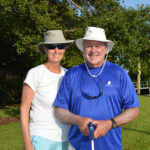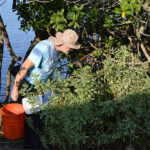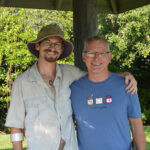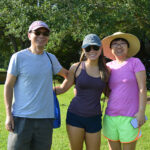
There has been quite a bit of “trash talk” lately, but a lot of it was about cleaning up the Indian River Lagoon during the 14th annual Treasure Coast Cleanup, which took place July 17-25.
Roughly 125 miles of waterway, from the Blowing Rocks Preserve in Hobe Sound to the Sebastian Inlet, were tended to by more than 1,000 volunteers working the shoreline, paddling by kayak and canoe or puttering along in motorboats, as they cleaned up waterways in the tri-county area.
In Indian River County, volunteers collected more than half a ton of trash, an estimated 1,111 pounds, from Riverside Park, Wabasso Causeway, the Sebastian Main Street Boat Ramp, Sebastian Inlet Marina and Vero Beach Municipal Marina.
April Price, event organizer, said that in the early years of the cleanup, approximately 11 tons of garbage had been collected annually, but that the number has been decreasing over time. Not including this year, a total of 91.5 tons has been logged over the first 13 years. This year’s numbers are still being finalized, but so far show that approximately 6,390 pounds has been collected across all three counties.
Due to the pandemic, last year’s event was virtual, with participants picking up trash on their own, and reporting in. This year’s event was a hybrid, with some volunteers opting to do it on their own over the course of the week or participating with groups on the final day.
Participants cataloged and submitted information on the types of items collected, the number of bags and their weight, and other information meant to help organizers analyze the health of the lagoon and areas of concern.
Some of the more interesting items found this year were a wet suit, shotgun shells and a volleyball, but nothing to beat the glass eye found several years ago, said Price. There were also golf and tennis balls, picnic trash, clothing, broken grills and chairs, and pandemic-related masks and gloves.
“It’s part of our mission to help all people learn to be better stewards of our environment. Removing pollution from our natural areas is something that we do throughout the year,” said Barbara Schlitt Ford, ELC executive director, and the site host at the Wabasso Causeway.
“It’s an amazing opportunity for us to all come together as a community. Together we can make a larger impact on our ecosystem, because we are all interconnected in our communities and in our natural resources,” added Amy Shea, ELC environmental educator.
The ELC has created an exhibit of marine debris – from this cleanup and others – to visually demonstrate the impact trash has on the environment.
The cleanup ties in nicely with Plastic Free July, a challenge started by the Plastic Free Foundation to draw attention to the excessive use of single-use plastics, which are found in great numbers in our waterways. Larger pieces become microplastics that never completely disappear and can greatly harm aquatic life.
“Our environmental problems are caused by multiple sources, and so we find that people get overwhelmed. They care, and they want to make a difference, and they come to us and say, ‘How can I as one person help?’” said Ford, who hopes program participants leave with a sense of empowerment.
“One person can make behavioral changes that, when multiplied exponentially by all the people doing it, really does have an impact. Just coming together in this way to work on it together, we’re building our eco-action society. We are trying to build a community of people that want to learn more about being part of the solution,” said Ford.
For more information, visit TCWaterwayCleanup.com.
Photos by Kaila Jones and provided
























